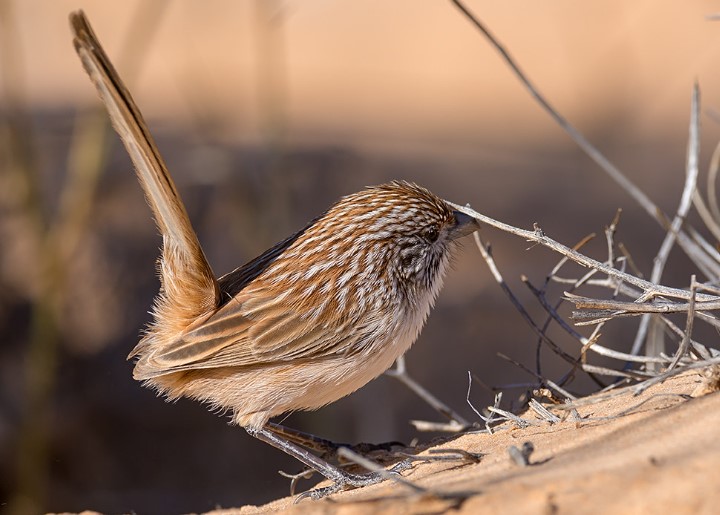Chiming Wedgebill Call and Song: Both sexes utter sweet, descending chimes of four to six notes, did-you-get-drunk, with emphasis on the last note, monotonously repeated. They are shyer and more elusive than the Chirruping. Singing birds call at irregular intervals throughout the day, but most frequently at dawn and late dusk, particularly when breeding, beaming the song out from the tops of bushes. Additionally, the chiming wedgebill produces cooing noises when it is mating.
Both sexes equally contribute to the song, which is a lovely falling chime of four to six notes that is frequently repeated. There is no antiphonal participation. This is only one of its differences from the similar-looking Chirruping Wedgebill, of which it was considered a race until the past decade.
Chiming Wedgebill In addition to the solos, they sing a duet in which the male and female sing together. The “add-on” feature, however, does not exist with Chiming Wedgebills; instead, she simply joins in with a few of her own when the male sings. Additionally, she calls alone.
Taxonomy: There are a number of bird species in the family Psophodidae, including the chiming wedgebill (Psophodes occidentalis) or chiming whip bird. In Australia, it is an endemic species. Both the chiming wedgebill and the chirruping wedgebill (Psophodes occidentalis) were previously considered to be single species. They were separated in 1973 due to the distinct calls of the two species.
Description: Chiming Wedgebills are also more uniformly grey, with a little hint of breast streaking, and have distinctly longer tails. The Chiming replaces the Chirruping in arid eastern and central Australia, living in more open shrubberies intermingled with taller mulga Acacia aneura woodland. Where the two meet, around the northern and western fringes of the Simpson Desert and the western Lake Eyre basin, there is no evidence of intergradations.
They probably arose and diverged within several million years, when their common ancestral population spread across inland Australia, divided down the middle by progressively drier weather patterns and maybe by seawater barriers in the nearby inland lakes. Like the Chirruping Wedgebill, the Chiming is communal, with groups of up to 20 or more occupying small territories in pockets of shrubbery year-round.
Diet: They feed on the ground and low branchlets under sheltering shrubbery, picking up seeds and insects, and their low dashing flight is of flutters and glides with a part-spread tail flashing its white tip.
Eggs: There are two or three eggs, with blue to blue-green with black and grey-purple spots, especially at the larger end; tapered-oval, about 24 x 1 7 mm. The incubation period lasts for 17 days. After breeding, inland birds may gather in larger wandering flocks lined with finer grass and rootlets, placed in dense, prickly wattles or clumps of mistletoe 1-3 m above ground.
Distribution: A rid acacia and melaleuca scrub/and with pockets of shrubbery, in Midwestern and central Australia, west to the coast, east to the Simpson Desert, and Lake Eyre. No races.

Identification: Adults: The sexes are similar, but the male is a little larger. The head and upper parts are uniformly mid-gray-brown, with a prominent dusky crest. The wings and tail are duskier, with white-shafted outer wing quills and broad white tips on all but the central pair of tail feathers. Moreover, the underparts are pale gray. And the eyes are dark brown with a black bill. The feet are grayish-black. IMMATURES: As adults, they are softer, plumaged, pale pink-brown, and have brown feet. Thus, the juveniles washed cinnamon on their wings; the crest was feathery.
Nesting: Chiming Wedgebill breeds from February to May and then from August to November. The bird builds a nest in a flattened cup, loosely constructed of small sticks and grass.
Other Names: It has other names like Crested Wedgebill, Chimes-bird, Daylight Bird, Kitty-lintol, chiming whip bird,
Size: The Chiming Wedge bill is about 200–220 mm in length.







